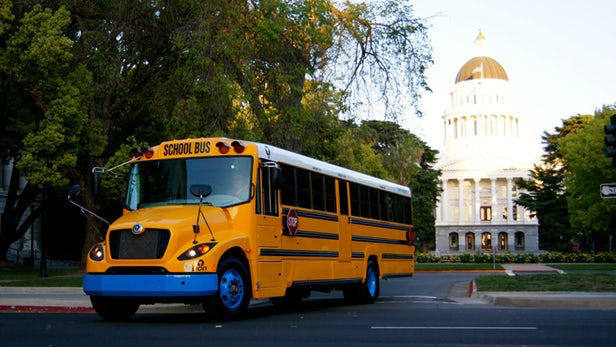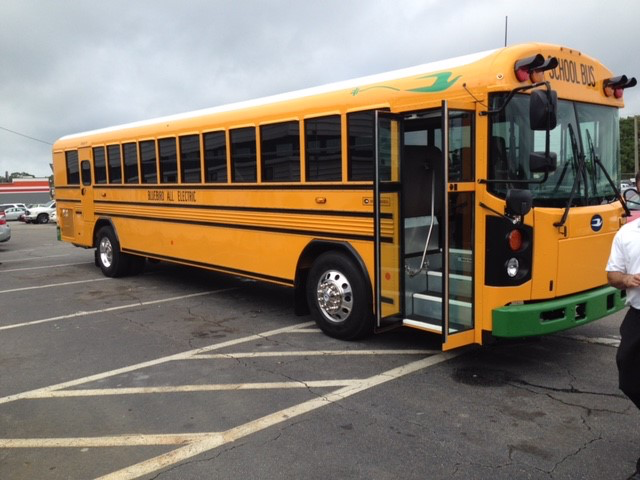By: Lucas Bravo, Walt Whitman High School
Around the country, local and state governments are trying to pass legislation in order to add electric busses to their school bus fleets. In some places, like the Gilroy, Napa, and Torrance Districts in California, electric busses are already a part of their fleets. Legislators, especially in the northwest, are hesitant to pass legislation allowing for electric busses to be a part of their fleets, due to cabin temperature regulations for cold winters and hot summers. Most electric buses are not capable of using heaters and air conditioning units, because it could drain the batteries. Heater units are crucial to creating safe transportation to and from school, to accommodate the large temperature swings in temperate environments. While this poses a problem to passing legislation in support of electric busses, it will likely be short lived, as many solutions are currently being presented. One solution is the installation of solar panels on their roofs to provide more kilowatt hours (kWh) that could be used for heating. Another solution could be to add gas heaters so that while the bus is running it doesn’t lose charge on heating. Also, solar panels could be placed on top of covered charging stations to reduce the amount of electricity needed from power plants.
The main benefit of electric busses is that they do not require gasoline, a resource that while it is currently quite economical natural gas and oil reserves are slowly dwindling in size and will become unreliable in the near future at our current rate of consumption. In 2017, the United States consumed 7.28 billion barrels of petroleum products (AGI). Luckily though, over the last two decades, vehicles that use petroleum have been getting consistently more fuel efficient. In a study done by Michael Sivak and Brandon Schoettle at the University of Michigan, it was observed that in April 2015 the average car got 25.2 miles per gallon (mpg). Compared to the average car in October 2007 which got 20.1 mpg, cars have become 25% more fuel efficient (Slate). The transportation industry is already making leaps and bounds lowering fuel consumption. By replacing the current petrol bus fleets with electric ones the transportation industry could lead the way to cleaner traveling.

https://cleantechnica.com/2016/05/17/elion-shows-off-new-electric-school-bus/
Some companies and manufacturers are already designing and selling electric busses. Lion and Blue Bird, two bus manufacturers released multiple Electric Bus products. Lion electric currently has three electric school busses for sale: The Lion A, the Lion C, and the Lion M. Each has a 100 mile battery life which is more than enough for any bus route and can be customized for a smaller battery for less demanding commutes. The Lion C can hold up to 72 passengers while the Lion A and Lion M can only hold a maximum of 26 passengers. In terms of allocating resources Lions A & M models should be used for less populated routes and the C model for more populated routes. Similarly, Blue Bird has two of their own electric bus products: the Type A Micro Bird G5 and the Type D All American. As implicated in their names, the Micro Bird is a smaller bus that can fit up to 30 passengers and the All American is a larger bus that can fit up to 84 passengers. Both busses have 100 mile batteries but are available in smaller battery options as well. Both companies have been selling their electric busses to American school districts and to other countries as well.
 http://fleetnewsdaily.com/blue-bird-american-electric-school-bus/
http://fleetnewsdaily.com/blue-bird-american-electric-school-bus/
Especially now more than ever, the need for alternatives to gasoline vehicles is higher than ever. In order to make a difference in Montgomery County and be an example for the rest of the state, it is necessary to eliminate emissions as much as possible and ideally emissions could be eliminated completely. Electric school buses are one step in the right direction. Some other ideas for making schools more eco friendly is to propose better alternatives to cars or buses. In California schools, walking and biking are proven to have decreased levels of pollution compared to schools that had more car and bus favored cultures.
Earlier this week I saw somebody driving to my school who literally lives on the same street as my school not even ten houses away. If my school encouraged students to walk, bike or take the bus, traffic by my school would significantly decrease. Students and parents driving their kids to school account for as much as 33% of commuters in the morning. So not only would commuting to school become more efficient, morning traffic would decrease significantly meaning everybody gets where they are going a lot faster.
References
Can Electric School Buses Go the Distance? – Alternative Fuels – School Bus Fleet. (2016). Schoolbusfleet.com. Retrieved 21 March 2019, from https://www.schoolbusfleet.com/article/713421/can-electric-school-buses-go-the-distance
How much oil is consumed in the United States?. (2014). American Geosciences Institute. Retrieved 21 March 2019, from https://www.americangeosciences.org/critical-issues/faq/how-much-oil-consumed-united-states
Lambert, F., & Lambert, F. (2017). New all-electric school buses unveiled by Blue Bird with Vehicle-to-Grid feature. Electrek. Retrieved 21 March 2019, from https://electrek.co/2017/07/14/all-electric-school-buses-blue-bird/
Saferoutespartnership.org.(2019) Retrieved 21 March 2019, from https://www.saferoutespartnership.org/site
Slate’s Use of Your Data. (2019). Slate Magazine. Retrieved 21 March 2019, from https://slate.com/business/2015/05/oil-use-in-transportation-this-chart-shows-how-it-s-losing-ground.html





